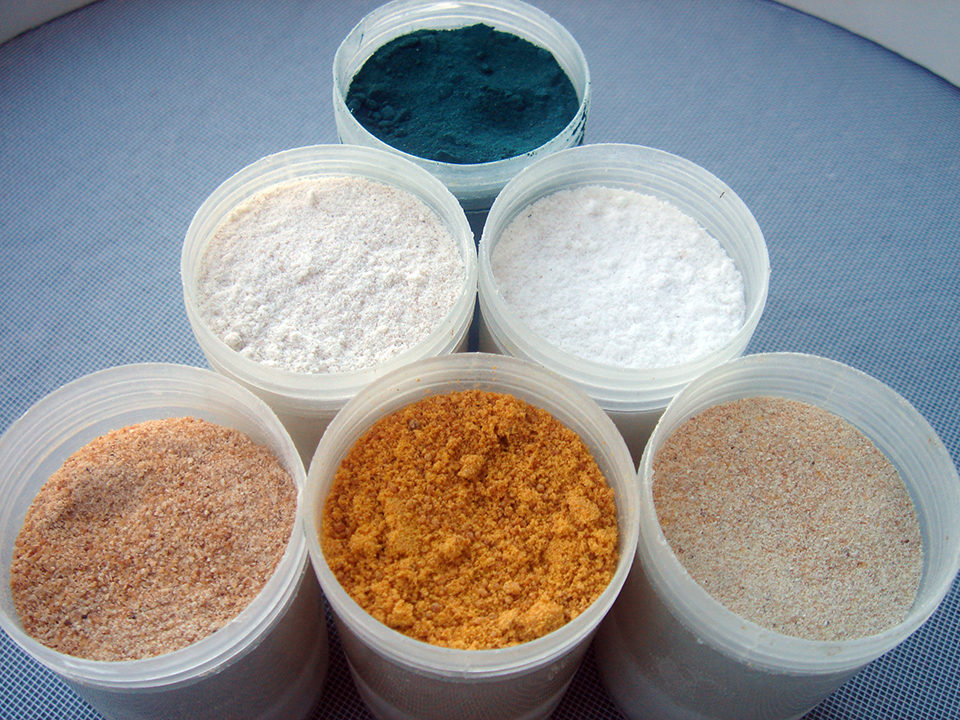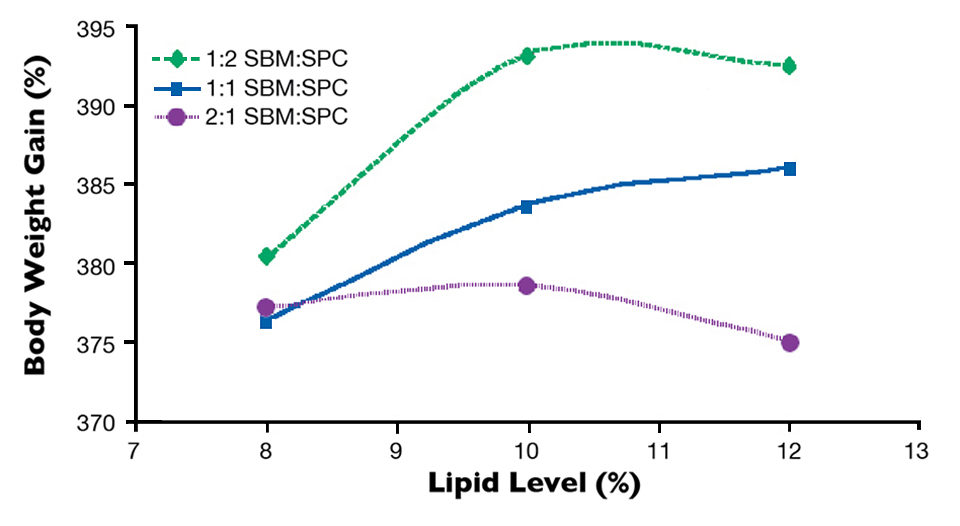L. vannamei can perform well on diets based solely on plant protein

Although farm-raised shrimp are regarded as omnivorous species, they remain the largest consumers of fishmeal within the aquaculture industry. However, inclusion of fishmeal in shrimp diets has been considerably reduced over the past 15 years, from an estimated 28 percent in 1995 to about 12 percent last year. If this trend continues, protein in shrimp diets will increasingly be derived from plant sources.
Soy products
Soybeans are the most significant oilseeds produced globally, with annual harvests exceeding 250 million metric tons. About one-fourth of this output is converted into meals and cakes for use in the animal feed industry. In aquatic feeds, soybean-derived ingredients include protein and lipid-rich sources, such as soybean meal (SBM), soy protein concentrate (SPC), soybean oil and soy lecithin. The latter two are used primarily to supply energy, essential fatty acids and phospholipids in feeds for farm-raised fish and crustaceans.
Today, several industrially manufactured shrimp feeds are soybean-based. Almost half of the composition of some grower shrimp feeds, for example, consist of SBM. SBM is an inexpensive source of digestible protein that contains as much as 48 percent crude protein and the best essential amino and profile for pond-raised shrimp among vegetable ingredients.
A more refined source of soy protein is SPC, in which soluble carbohydrates are removed and anti-nutritional factors are reduced during processing. In SPC, crude protein levels can reach as high as 65 percent. Use of SPC in shrimp diets is less common, but SPC is becoming more widely accessible, allowing the reduction of non-renewable and more expensive protein ingredients such as fishmeal.
Feeding trial
The authors performed a study to evaluate the performance of Pacific white shrimp, Litopenaeus vannamei, given plant protein-based diets with varying levels of lipid content and SBM:SPC ratios.
Shrimp were fed nine isonitrogenous diets formulated to contain 360 g/kg of crude protein with varying lipid levels and SBM:SPC ratios. Protein in the diets was only of plant origin (Table 1). Formulas contained Spirulina meal to act as an attractant and palatability enhancer. Fish oil was fixed at 20 grams/kg to meet minimum essential fatty acid requirements.
Nunes, Diet composition (g/kg), Table 1
| Composition/Lipid Level | 1:2 SBM:SPC 12% | 1:2 SBM:SPC 10% | 1:2 SBM:SPC 8% | 1:1 SBM:SPC 12% | 1:1 SBM:SPC 10% | 1:1 SBM:SPC 8% | 2:1 SBM:SPC 12% | 2:1 SBM:SPC 10% | 2:1 SBM:SPC 8% |
|---|
Composition/Lipid Level | 1:2 SBM:SPC 12% | 1:2 SBM:SPC 10% | 1:2 SBM:SPC 8% | 1:1 SBM:SPC 12% | 1:1 SBM:SPC 10% | 1:1 SBM:SPC 8% | 2:1 SBM:SPC 12% | 2:1 SBM:SPC 10% | 2:1 SBM:SPC 8% |
|---|---|---|---|---|---|---|---|---|---|
| SPC | 345.0 | 345.0 | 346.7 | 260.0 | 260.0 | 260.0 | 157.5 | 154.6 | 152.2 |
| Soybean meal | 150.0 | 150.0 | 150.0 | 260.0 | 260.0 | 260.0 | 400.0 | 400.0 | 400.0 |
| Corn gluten meal | 67.1 | 64.9 | 62.2 | 74.9 | 72.7 | 70.4 | 80.0 | 80.0 | 80.0 |
| Broken Rice | 67.0 | 90.0 | 100.0 | 36.7 | 58.7 | 81.6 | 0.0 | 18.6 | 41.8 |
| Soybean oil | 67.0 | 46.3 | 21.1 | 65.4 | 44.7 | 24.0 | 63.5 | 42.7 | 21.9 |
| Other* | 303.9 | 303.8 | 320.0 | 303.0 | 303.9 | 304.0 | 299.0 | 304.1 | 304.1 |
Table 1. Diet composition (g/kg) of plant-protein diets.
SBM and SPC inclusion varied at the cost of corn gluten meal and broken rice. Corn gluten meal was used as a source of intact methionine. SBM and SPC inclusion levels were 150 and 345 grams/kg (1:2 ratio), 260 and 260 grams/kg (1:1), and 400 and 155 grams/kg (2:1), respectively. Three sets of lipid levels met primarily by soybean oil were used for each formulated SBM:SPC ratio: 12, 10 and 8 percent.
Another diet containing 8 percent total lipid was designed as a control. It used 450 grams/kg of SBM, 200 grams/kg of wheat flour, 120 grams/kg of salmon fishmeal, 40 grams/kg of corn gluten and 20 grams/kg of meat and bone meal as protein ingredients.
About 2,000 shrimp with wet body weights of 3.13 ± 0.35 grams were stocked under 70 animals per square meter in 50, 500-L clearwater tanks and reared for 86 days. Animals were fed twice a day exclusively from feeding trays. Five replicate tanks were allowed per diet type. Water quality parameters did not vary statistically among feeding treatments: 36 ± 2.1 ppt salinity, 7.9 ± 0.18 pH and 28.5 ± 0.56 degrees-C temperature.
Results
At harvest, there was a trend toward higher shrimp weight gain as the SBM:SPC ratio reduced in the diets from 2:1 to 1:2 (Fig. 1). At the 1:2 SBM:SPC ratio, higher shrimp body weight was observed when the lipid content in the diet was 10 percent (12.3 ± 1.78 grams) and 12 percent (12.3 ± 1.85 grams) compared to 8 percent (11.7 ± 2.16 grams).

Final survival was lower when shrimp fed diets containing 12 percent lipid with 1:1 SBM:SPC (86.5 ± 8.2 percent) and 10 and 8 percent with 2:1 SBM:SPC (87.0 ± 5.4 percent and 86.5 ± 5.8 percent, respectively) were compared to the control diet (96.5 ± 4.2 percent). Shrimp feed intake increased significantly as lipid level was reduced from 12 percent (11.9 ± 0.4 grams/stocked shrimp) to 8 percent (12.6 ± 0.4 grams/shrimp) at the 2:1 SBM:SPC ratio. There was no statistical difference in shrimp growth rate (0.72 ± 0.10 grams/week), feed-conversion ratio (2.34 ± 0.48) and yield (532 ± 89 grams per square meter) among the different diets.
Perspectives
Results indicated that L. vannamei can perform well on diets based solely on plant proteins. Higher inclusions of SPC can benefit shrimp performance. The recommended SBM:SPC ratio for plant-based diets fed to white shrimp is 1:2 combined with a 10 percent total lipid content. A minimum inclusion of 2 percent fish oil is required.
(Editor’s Note: This article was originally published in the March/April 2011 print edition of the Global Aquaculture Advocate.)
Authors
-
Alberto J.P. Nunes, Ph.D.
Instituto de Ciências do Mar
Av. da Abolição, 3207 – Mereles
Fortaleza, Ceará 60165-081 Brazil -
Marcelo V. C. Sá, Ph.D.
Instituto de Ciências do Mar
Av. da Abolição, 3207 – Mereles
Fortaleza, Ceará 60165-081 Brazil -
Hassan Sabry-Neto, M.S.
Instituto de Ciências do Mar
Av. da Abolição, 3207 – Mereles
Fortaleza, Ceará 60165-081 Brazil
Tagged With
Related Posts

Intelligence
A land grab for salmon (and shrimp) in upstate New York
The operators of Hudson Valley Fish Farm see their inland locale as a pilot to prove that land-based fish farming, located in close proximity to major metropolitan markets, can be successful.

Aquafeeds
A look at corn distillers dried grains with solubles
Corn distillers dried grains with solubles are an economical source of energy, protein and digestible phosphorus to reduce feed costs and fishmeal usage.

Aquafeeds
A look at phospholipids in aquafeeds
Phospholipids are the major constituents of cell membranes and are vital to the normal function of every cell and organ. The inclusion of phospholipids in aquafeeds ensures increased growth, better survival and stress resistance, and prevention of skeletal deformities of larval and juvenile stages of fish and shellfish species.

Aquafeeds
Algae alternative: Chlorella studied as protein source in tilapia feeds
Chlorella and other species have potential as protein sources in aquafeeds. In trials with tilapia fry raised in a recirculating system, the fish received a fishmeal-based control diet or feeds with portions of the fishmeal replaced by Chlorella.


